Lucy’s relationship to Schroeder was unfulfilling. She craved emotional validation from the one character who was least equipped to provide it. It was both humorous and sad – a contradictory message that Charles Schulz’s Peanuts conveyed so well.
Lucy debuted as a toddler in 1952. Schulz declined to reprint these early strips for many years, though he relented before his death. Fantagraphics published all of them as part of its The Complete Peanuts anthology in 2004.


Many of these early Lucy strips concerned the self-centred nature of toddlers. Toddlers, as a matter of mental development, don’t place the needs and wants of others over their own. Their selfishness isn’t deliberate or malicious; it’s simply who they are. Thus, the humour of these toddler strips stemmed from attaching adult motivations to Lucy’s babyish actions.
Over the next two years, Schulz retconned Lucy to be the same age as her counterparts, though she kept her manipulative charm. But without her childish naïveté, her behaviour was no longer cute. Lucy’s peers reacted to her boldness with a mixture of surprise and disgust.


Lucy’s behaviour often read as malicious, especially since her younger brother Linus was wiser and more generous than she was. Physically, she had grown, but emotionally, she was stunted. She still craved attention and immediate gratification, and she went about fulfilling these cravings through bullying and disingenuousness.
Lucy developed a crush on Schroeder in May 1953, at the beginning of her post-toddler phase. Unlike her father, who doted upon her, or Linus, who looked up to her in spite of her behaviour, Schroeder ignored Lucy entirely. So Lucy imposed herself upon him. She climbed on top of his piano and stared him in the face until she broke his focus.

A 1955 strip revisited the same themes. Again, Lucy was fascinated by Schroeder’s lack of acknowledgement and felt compelled to intrude upon his space. Everyone else in her social orbit – even Violet and Patty – accommodated or folded to her tantrums. Schroeder didn’t, and that’s exactly what Lucy liked about him.

Schroeder was one of Schulz’s least developed characters, despite his long tenure with the strip. Beethoven and classical music consumed him, taking precedence over his real life friends. This hindered his character development; when the punchline to every Schroeder strip was “Beethoven”, there was little room for Schulz to develop the character’s inner life.

Over time, as Snoopy rose in prominence and Linus and Sally got older Schroeder became increasingly peripheral to the strip’s world. Meanwhile, Peanuts evolved to be less reliant on the characters’ quirks and more reliant on their chemistry with one another.
Through this, Schroeder remained mostly one-dimensional. Lucy interacted with him more than any other character, even though he ignored her. She was the only person who challenged him, albeit for selfish reasons, to do something other than obsess over Beethoven.
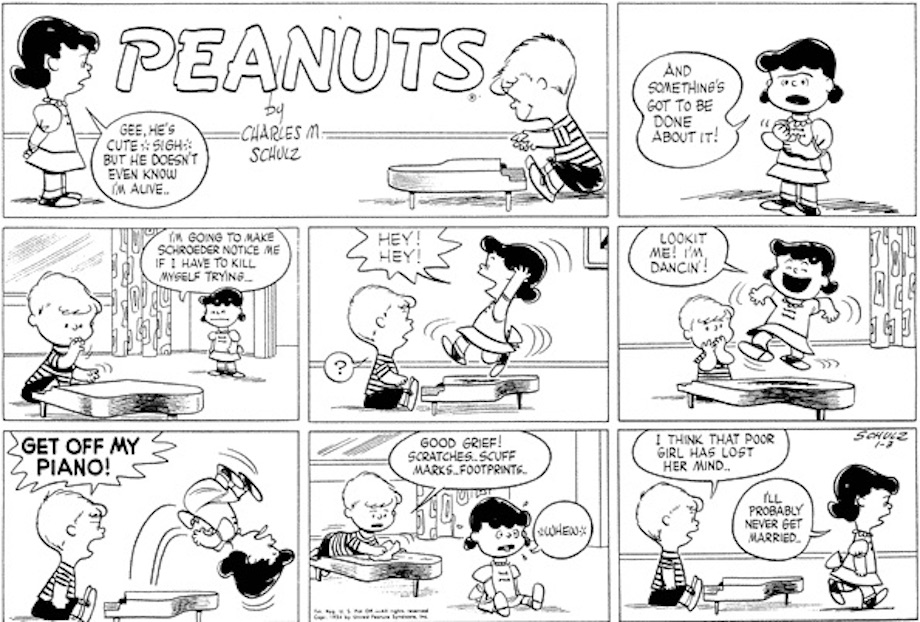
Lucy went about this in different ways. Sometimes she would distract him from his music by presenting herself as a more entertaining alternative. This invariably failed. Other times, she denigrated Beethoven’s importance and minimised Schroeder’s piano playing. This only caused him to dig his heels in deeper.

Lucy would also strategise in the other direction: She’d take an interest in Beethoven by reading up on him and making token, misplaced gestures of support. She’d inform the neighbourhood about Beethoven’s birthday, for example, but mistakenly tell everyone his name was Karl instead of Ludwig.
Finally, when she had exhausted all options, Lucy would physically destroy her competition, but that didn’t work either. The things she destroyed were symbols of Schroeder’s interests, not his actual interests, and he had plenty of them.
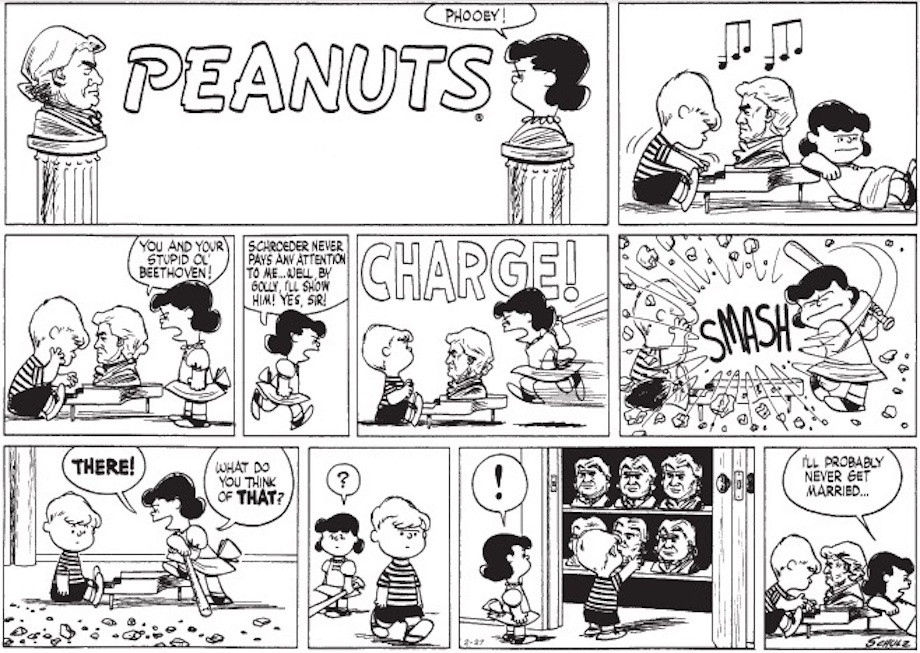
Despite her relentlessness, Lucy was never going to find the “real” Schroeder beneath his artist persona because, from all indications, Schroeder never developed an identity beyond that persona. To paraphrase Gertrude Stein: When it came to Schroeder, there was no “there” there.

And thus, Lucy’s fascination with Schroeder became the most interesting thing about him. He could have easily gone the way of Shermy and disappeared from the strip entirely, had Lucy not used him as a sounding board for her own neuroses and insecurities. Many times, Schroeder wouldn’t even speak, or he would sneak out of the room and leave Lucy talking to herself.
Their strips became less about Lucy wooing Schroeder and more about Lucy exploring her own emotional landscape.
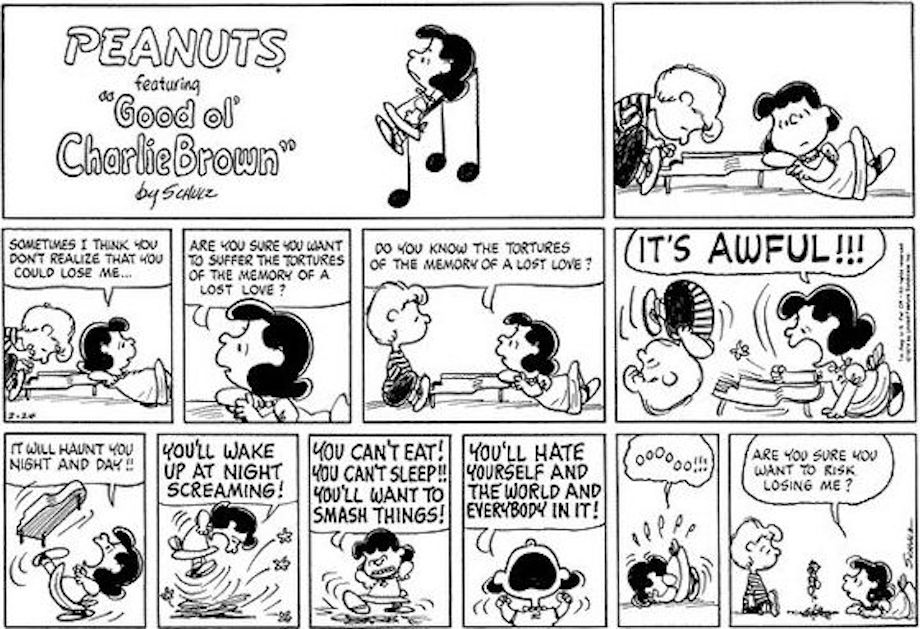
Over the years, the reader empathised less with Schroeder and more with Lucy, even though she was the initial aggressor in this dysfunctional dynamic. At least she had some skin in the game – she opened herself to rejection every time she leaned on Schroeder’s piano. Schroeder was never open, and at times, he even seemed to take pleasure in his cruel reactions to her flirtations.
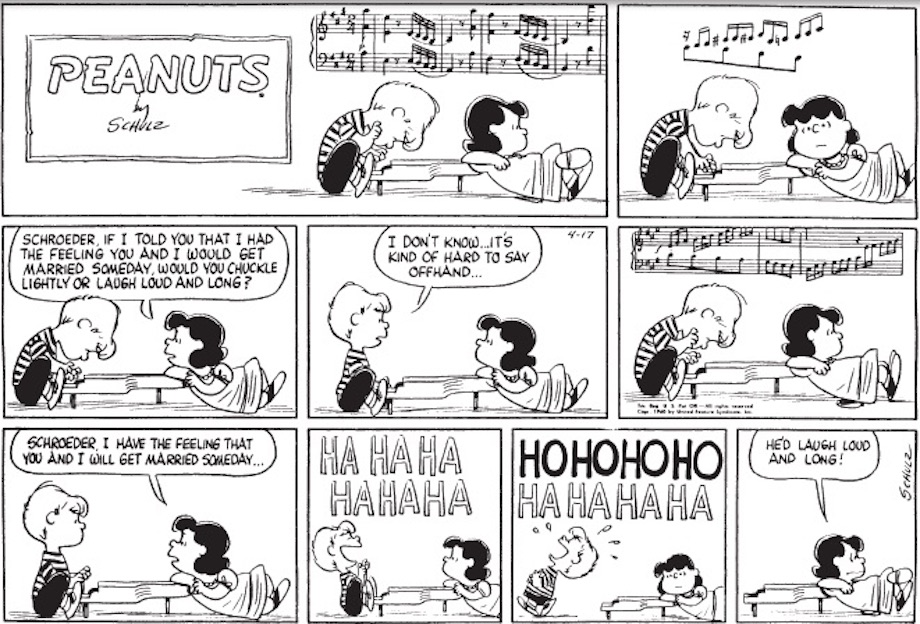
By 1966, Lucy’s relationship with Schroeder bordered on masochistic. She persisted in her efforts to win him over, despite his indifference.
During a multi-day, extended storyline during which Lucy and Linus moved away, Schroeder realised he missed her. He couldn’t play his piano without her there. Like Charlie Brown in the storyline, the reader is irritated at Schroeder for his prior callousness and emotional constipation.


The final line of the above strip is an allusion to the play Pygmalion and its subsequent musical adaption My Fair Lady. In both the play and the musical, an emotionally abusive linguistics professor, Henry Higgins, takes an unrefined flower girl, Eliza Doolittle, under his tutelage.
By the end of the play, a newly empowered Eliza declares to Higgins, “I know I’m a common ignorant girl, and you a book-learned gentleman; but I’m not dirt under your feet.”
By casting Schroeder in the role of Higgins, Schulz offers the same cutting critique. Schroeder took Lucy for granted and felt his intellect could absolve him of emotional attachment and wrongdoing.
It didn’t, but even after experiencing heartbreak, Schroeder learned nothing. When Lucy moved back home at the end of the storyline, she resumed her place at the foot of his piano. Schroeder didn’t even acknowledge her until, once again, she intruded on his space.

There was one notable occasion, in 1972, when Lucy found her dignity. The Peanuts gang was playing baseball, and Lucy was next up at bat. Schroeder insulted her by proposing what he considered an impossible bet: He had to kiss her at home plate if she hit a home run. Lo and behold, she did. Schroeder looked devastated. Lucy floated on air as she rounded the bases.

Lucy saw Schroeder waiting at home plate, lips puckered and eyes closed, clearly hating every moment. She realised that kissing him would be humiliating for her. So she walked right past him instead of giving everyone a show to gawk at or giving Schroeder the opportunity to “BLEAH!” and shame her.

The final line, where Lucy claimed her act as a triumph of women’s liberation, is humorous in its hyperbole. But for Lucy, this was a significant moment of victory and personal growth.
For so many years, Lucy idealised a life of domestic bliss with Schroeder. Finally, she realised that it degraded her to cajole a reluctant participant. She deserved an equal partner – far more than than the sort of Higgins/Eliza dynamic that Schroeder would provide. The only way she could win, counterintuitively, was by walking away.
Lucy evolved. Once, she was an entitled child who felt that the world owed her something. She couldn’t handle rejection and settled for negative attention. Eventually, however, she found the strength to want better for herself.
Schulz rarely gave his characters everything they wanted. But the world of Peanuts was never completely hopeless. There were always small victories and glimmers of hope scattered amongst the setbacks.
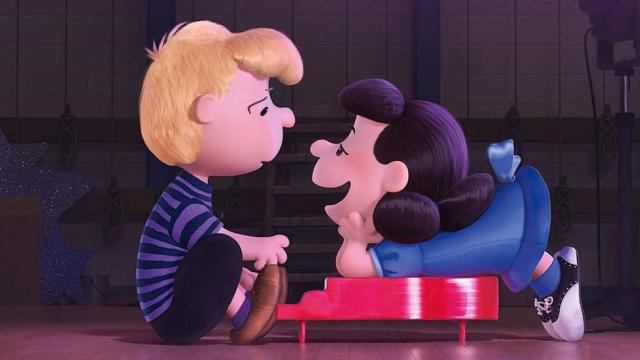
Comments
One response to “How Peanuts Used Lucy And Schroeder To Explore Dysfunctional Relationships”
I love these articles.